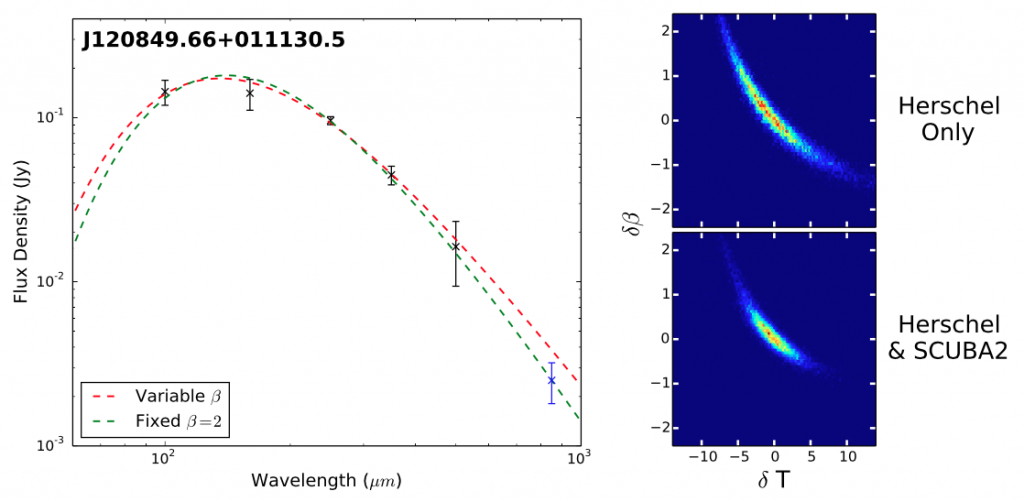– A new local galaxy evolution legacy survey
JINGLE is a JCMT Large Program designed to systematically study the cold ISM of galaxies in the local Universe. With 780 hours of observing, phase I will provide integrated 850μm continuum measurements with SCUBA-2 for a representative sample of 193 Herschel-selected galaxies, as well as integrated CO(2-1) line fluxes with RxA for more than 75 of these galaxies. Phase II extends JINGLE to galaxy populations occupying other regions of the SFR-stellar mass plane. Phase II will run from Feb. 2020 to January 2023. Phase II has been allocated 455 hours of observing time with Nāmakanui/`Ū`ū and SCUBA-2 to obtain CO(2-1) fluxes of starburst and green-valley galaxies, as well as dust continuum measurements for the starbursts.
For more information please visit the JINGLE homepage

Distribution of the JINGLE phase I & II targets and the parent galaxy sample (light grey dots) in the SFR-stellar mass (M★) plane. Galaxies targeted by the JINGLE phase I generally lie on the galaxy main sequence. Galaxies targeted by JINGLE phase II lie either above the main sequence in the high-sSFR starburst regime (red dots) or are green valley galaxies (green dots) with generally low SFRs compared to normal star-forming galaxies. For the selection of starbursts two commonly advocated main-sequence shapes were considered: (1) a single power law SFR ~ M★0.8 and (2) a curved main sequence with flattening at high masses.
The position of the sample in the SFR-stellar mass plane is shown in the figure above. The observations will allow for the robust characterisation of the dust properties, as well as the measurement of total molecular gas masses for the RxA/U’u subsample. JINGLE targets are selected from fields with MaNGA optical integral-field spectroscopic coverage, have mid- to far-IR photometry from WISE and the Herschel-ATLAS survey and coverage from upcoming, new, blind interferometric HI surveys.
The combination of all these datasets will allow a detailed characterisation of the gas and dust properties and of the kinematics and metal contents of these galaxies, the derivation of scaling relations between dust, gas, and global properties, as well as provide critical benchmarks for high-redshift studies with JCMT and ALMA. Specific science questions that will be addressed in phase I include:
- Determining dust emissivities and looking for systematic dependencies of β on global galaxy properties such as metallicity, stellar mass or SFR. As shown in the figure below, the addition of the SCUBA-2 data significantly increases the accuracy of the simultaneous measurement of dust temperatures and β over a Herschel-only sample.

Left: H-ATLAS photometry of J120849.66+011130.5 (black points), with modified- blackbody models with different β overlaid: β = 1.5 (red dashed line) and β = 2.0 (green dashed line). Clearly, the Herschel data alone cannot distinguish between the two scenarios, but the addition of a data point at 850μm does (e.g. the blue data point is a predicted 850μm SCUBA-2 flux for β = 2). Right: Surface density plots showing the uncertainties in both β and Tdust for Monte-Carlo simulations of Herschel data only (top) and Herschel+SCUBA-2 data (bottom). The uncertainties on β and Tdust are drastically reduced with the addition of the SCUBA-2 850μm datum.
- Deriving scaling relations between dust mass and global galaxy properties. JINGLE’s statistically robust sample of galaxies with 850μm measurements as well as Herschel photometry will provide for the first time an unbiased view of dust scaling relations in the local universe.
- Studying the dust-to-gas mass ratio to establish if and how it varies as a function of stellar mass, metallicity, SFR, thus informing high redshift studies relying on dust measurements and a dust-to-gas ratio to infer total molecular gas masses.
- Investigating the correlation between total cold gas and dust masses and spatially-resolved quantities from the MaNGA observations (such as gradients of SFR, metallicity, stellar age, ionisation mechanisms,..). This information will shed new light on the question of star formation quenching and its link to changes in the internal structure of galaxies.
The main science drivers of the JINGLE phase II are:
- To determine the relative importance of gas content and star-formation efficiency for producing the most vigorously starbursting galaxies in the local Universe.
- To assess whether there are different ‘flavours’ of starburst galaxies by comparing the gas and dust properties of (i) outliers to the galaxy main sequence displaying interaction signatures, and of (ii) visually unperturbed starbursts (Fig. 2).

Examples of starburst (1st/2nd row) and green-valley galaxies (3rd row) targeted by JINGLE phase II. Upper row – morphologically disturbed, merging starburst galaxies; middle row – generally unperturbed starbursts with disk-like structure. Some of these show traces of minor interactions (e.g. central stamp in this row). Lower row – green valley galaxies.
- To constrain the role of molecular gas for quenching the star formation activity of galaxies by investigating whether quenching is due to a depletion of gas reservoirs or a reduction of the star-formation efficiency.
- To provide crucial calibrations for high-z gas mass estimates relying on monochromatic dust continuum fluxes, by quantifying how L’CO/L850 ratios vary across a broad range of galaxy properties.
By using the full JINGLE database, we will compare the interstellar medium properties of the outlier populations – i.e. starbursts and green valley galaxies – with those of ‘normal’ main sequence galaxies.
Coordinators: H. S. Hwang (EAO/Korea), L.-H. Lin (EAO/Taiwan), A. Saintonge (UK), M. Sargent (UK), T. Tosaki (EAO/Japan), Y. Koyama (EAO/Japan), T. Xiao (EAO/China), C. Wilson (Canada)
– The JINGLE ADS Library can be accessed here
– JCMT program code: M16AL005, M17BL010, M20AL013



